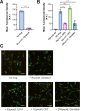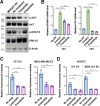Lung Fibroblasts Take up Breast Cancer Cell-derived Extracellular Vesicles Partially Through MEK2-dependent Macropinocytosis
- PMID: 38259097
- PMCID: PMC10802141
- DOI: 10.1158/2767-9764.CRC-23-0316
Lung Fibroblasts Take up Breast Cancer Cell-derived Extracellular Vesicles Partially Through MEK2-dependent Macropinocytosis
Abstract
Extracellular vesicles (EV) have emerged as critical effectors in the cross-talk between cancer and normal cells by transferring intracellular materials between adjacent or distant cells. Previous studies have begun to elucidate how cancer cells, by secreting EVs, adapt normal cells at a metastatic site to facilitate cancer cell metastasis. In this study, we utilized a high-content microscopic screening platform to investigate the mechanisms of EV uptake by primary lung fibroblasts. A selected library containing 90 FDA-approved anticancer drugs was screened for the effect on fibroblast uptake of EVs from MDA-MB-231 breast cancer cells. Among the drugs identified to inhibit EV uptake without exerting significant cytotoxicity, we validated the dose-dependent effect of Trametinib (a MEK1/2 inhibitor) and Copanlisib (a PI3K inhibitor). Trametinib suppressed macropinocytosis in lung fibroblasts and inhibited EV uptake with a higher potency comparing with Copanlisib. Gene knockdown and overexpression studies demonstrated that uptake of MDA-MB-231 EVs by lung fibroblasts required MEK2. These findings provide important insights into the mechanisms underlying lung fibroblast uptake of breast cancer cell-derived EVs, which could play a role in breast cancer metastasis to the lungs and suggest potential therapeutic targets for preventing or treating this deadly disease.
Significance: Through a phenotypic screen, we found that MEK inhibitor Trametinib suppressed EV uptake and macropinocytosis in lung fibroblasts, and that EV uptake is mediated by MEK2 in these cells. Our results suggest that MEK2 inhibition could serve as a strategy to block cancer EV uptake by lung fibroblasts.
© 2024 The Authors; Published by the American Association for Cancer Research.
Figures






Similar articles
-
Extracellular vesicles of carcinoma-associated fibroblasts creates a pre-metastatic niche in the lung through activating fibroblasts.Mol Cancer. 2019 Dec 3;18(1):175. doi: 10.1186/s12943-019-1101-4. Mol Cancer. 2019. PMID: 31796058 Free PMC article.
-
A Systematic Evaluation of Factors Affecting Extracellular Vesicle Uptake by Breast Cancer Cells.Tissue Eng Part A. 2017 Nov;23(21-22):1274-1282. doi: 10.1089/ten.TEA.2017.0158. Epub 2017 Jul 20. Tissue Eng Part A. 2017. PMID: 28586292 Free PMC article.
-
MEK2 controls the activation of MKK3/MKK6-p38 axis involved in the MDA-MB-231 breast cancer cell survival: Correlation with cyclin D1 expression.Cell Signal. 2016 Sep;28(9):1283-1291. doi: 10.1016/j.cellsig.2016.05.009. Epub 2016 May 13. Cell Signal. 2016. PMID: 27181679
-
Extracellular vesicles in cancer therapy.Semin Cancer Biol. 2022 Nov;86(Pt 2):296-309. doi: 10.1016/j.semcancer.2022.06.001. Epub 2022 Jun 8. Semin Cancer Biol. 2022. PMID: 35688334 Free PMC article. Review.
-
Routes and mechanisms of extracellular vesicle uptake.J Extracell Vesicles. 2014 Aug 4;3. doi: 10.3402/jev.v3.24641. eCollection 2014. J Extracell Vesicles. 2014. PMID: 25143819 Free PMC article. Review.
Cited by
-
Triple-Negative Breast Cancer EVs Modulate Growth and Migration of Normal Epithelial Lung Cells.Int J Mol Sci. 2024 May 28;25(11):5864. doi: 10.3390/ijms25115864. Int J Mol Sci. 2024. PMID: 38892050 Free PMC article.
-
Osteosarcoma Exosome Priming of Primary Human Lung Fibroblasts Induces an Immune Modulatory and Protumorigenic Phenotype.Cancer Res Commun. 2025 Apr 1;5(4):594-608. doi: 10.1158/2767-9764.CRC-24-0371. Cancer Res Commun. 2025. PMID: 40099972 Free PMC article.
References
Publication types
MeSH terms
Substances
Grants and funding
LinkOut - more resources
Full Text Sources
Medical
Molecular Biology Databases
Research Materials
Miscellaneous

